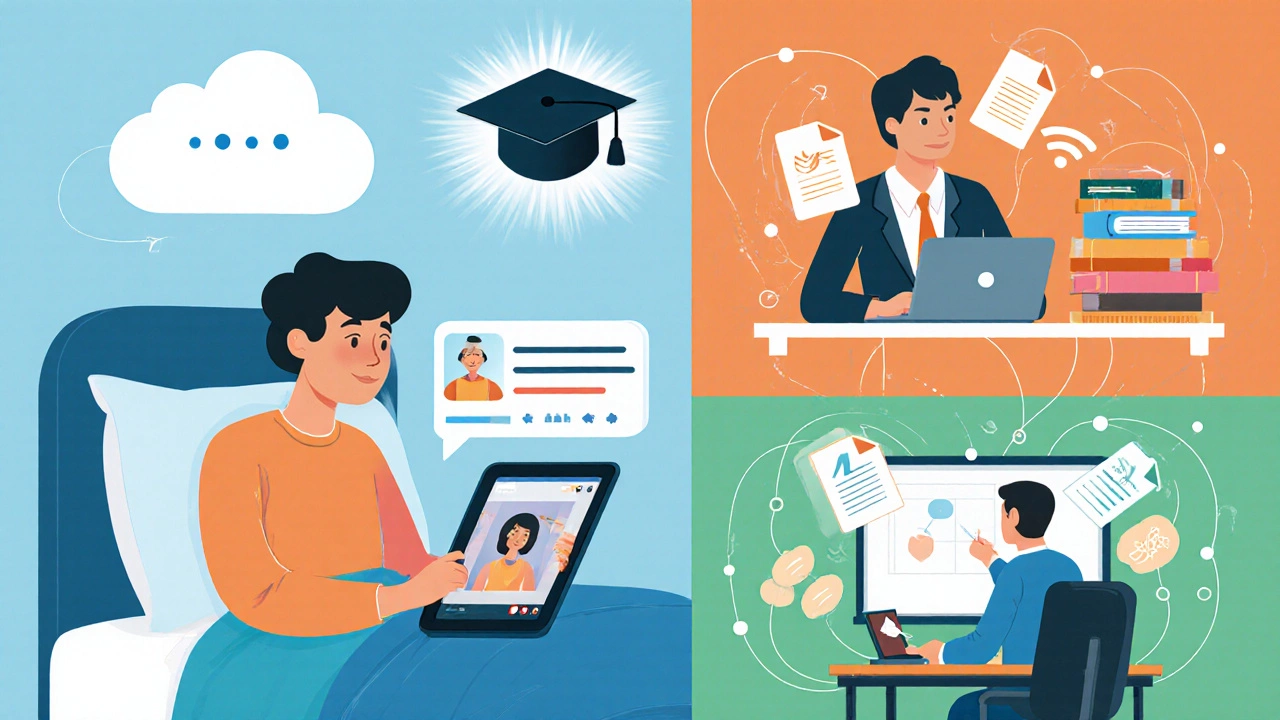Distance Education Compatibility Quiz
How well does distance education fit your lifestyle?
This short quiz helps you understand if distance learning aligns with your personal strengths, technology access, and learning preferences. Answer the questions honestly to receive tailored feedback.
When people ask for a distance education definition, they’re usually looking for a clear, concise way to tell the difference between learning that happens behind a screen and the traditional classroom experience. In short, distance education is a structured form of learning that takes place when the teacher and the learner are separated by time, place, or both, yet remain connected through technology.
What is distance education?
Distance education is a formal learning arrangement where instruction, interaction, and assessment occur without the physical presence of students and instructors in the same location. It relies on digital platforms, printed materials, or broadcast media to deliver content and facilitate communication. The definition has been stable for decades, but the tools and delivery methods keep evolving, blurring the line between “online” and “offline.”
Key characteristics of distance education
- Geographic independence - learners can join from anywhere with an internet connection.
- Temporal flexibility - courses may be designed for real‑time (synchronous) sessions, self‑paced (asynchronous) modules, or a blend of both.
- Technology‑mediated interaction - discussion boards, video conferencing, and learning management systems (LMS) replace face‑to‑face dialogue.
- Structured assessment - quizzes, assignments, and proctored exams are administered digitally or via mail.
- Accredited curricula - reputable programs align with national or regional qualification frameworks.
Types of distance education
Not all distance programs look the same. Below are the most common formats, each with its own flavor of interaction and delivery.
- Online learning delivers all course components via the internet, from video lectures to interactive quizzes.
- Blended learning mixes face‑to‑face sessions with online activities, giving the best of both worlds.
- Synchronous learning requires participants to be online at the same time for live lectures, chats, or virtual labs.
- Asynchronous learning offers pre‑recorded content and discussion boards that learners can access whenever they choose.
- Correspondence courses - material is mailed or emailed, and students return assignments by post or email.
Benefits and challenges
Distance education isn’t a magic bullet, but it does provide distinct advantages that make it appealing to many learners.
Benefits
- Accessibility: Students in remote regions, working adults, and people with disabilities can study without relocating.
- Cost savings: No commuting, lower tuition for some programs, and reduced textbook expenses thanks to digital resources.
- Personalized pacing: Asynchronous modules let fast learners move ahead and slower learners spend extra time on tough topics.
- Broader course selection: Learners can enrol in programs offered by institutions on the other side of the globe.
Challenges
- Self‑discipline: Without a physical classroom, procrastination becomes a real risk.
- Technology gaps: Reliable internet, a suitable device, and basic digital literacy are prerequisites.
- Limited hands‑on practice: Fields like medicine or engineering often need physical labs, which can be hard to replicate online.
- Social isolation: Fewer casual interactions may affect motivation and networking.

Technology that powers distance education
The backbone of any modern distance program is the software that delivers content and tracks progress.
- Learning Management System (LMS) is a platform that hosts course materials, grades, forums, and analytics-all in one place.
- Massive Open Online Course (MOOC) platforms such as Coursera or edX provide free or low‑cost courses from top universities to a global audience.
- Virtual classroom tools like Zoom, Microsoft Teams, or BigBlueButton enable live video, screen sharing, and breakout rooms.
- Adaptive learning engines that personalise quizzes based on a student's performance.
- Cloud‑based storage for large media files and collaborative documents.
Accreditation and quality assurance
Just because a course lives online doesn’t mean it’s automatically recognized.
In the UK, distance programs must meet the same standards as campus‑based courses under the Quality Assurance Agency (QAA). Internationally, agencies like the Distance Education Accrediting Commission (DEAC) in the U.S. provide a seal of credibility. When evaluating a program, look for:
- National or regional accreditation status.
- Clear learning outcomes and assessment rubrics.
- Qualified faculty with relevant academic credentials.
- Student support services, such as tutoring, career advising, and technical help.
How to choose a distance education program
Picking the right program is a personal decision, but a systematic checklist makes the process less stressful.
- Accreditation: Verify that the institution holds recognized accreditation.
- Delivery mode: Decide whether synchronous, asynchronous, or blended fits your schedule.
- Technology requirements: Ensure the LMS is compatible with your device and internet speed.
- Cost and financial aid: Compare tuition, fees, and available scholarships.
- Student outcomes: Look at graduation rates, job placement statistics, and alumni testimonials.

Future trends in distance education
The field isn’t static. Emerging technologies promise to reshape how we learn from afar.
- Artificial intelligence: AI tutors can give instant feedback on essays and adapt lesson difficulty in real time.
- Virtual and augmented reality: VR labs let science students conduct experiments in a simulated environment.
- Micro‑credentials: Short, stackable certificates that demonstrate specific skills without a full degree.
- Data‑driven personalization: Learning analytics guide educators to intervene before a student falls behind.
Comparison: Distance Education vs. Traditional Classroom Education
| Aspect | Distance Education | Traditional Classroom |
|---|---|---|
| Location | Remote - anywhere with internet | On‑campus facilities |
| Schedule | Flexible; synchronous or asynchronous | Fixed class times |
| Interaction | Digital forums, video calls, LMS chat | Face‑to‑face discussions |
| Cost | Typically lower tuition, no commuting | Higher tuition, facility fees |
| Assessment | Online quizzes, e‑proctoring, e‑portfolios | Paper exams, in‑person labs |
| Technology reliance | High - needs devices, broadband | Moderate - mostly classroom tech |
Quick checklist for a successful distance learning experience
- Set up a dedicated study space free from distractions.
- Maintain a weekly schedule - block time for live sessions, readings, and assignments.
- Test your internet speed and device compatibility before the first class.
- Engage actively in discussion boards; don’t treat them as an after‑thought.
- Reach out early to technical support if you encounter platform issues.
- Use the LMS analytics to monitor your progress and adjust study habits.
Frequently Asked Questions
Is a distance education degree as valuable as a campus degree?
If the program is accredited by a recognized agency, employers view it the same as a traditional degree. The key is to verify accreditation and check industry recognition before enrolling.
Do I need a fast internet connection for all distance courses?
Most asynchronous content (PDFs, recorded videos) works fine on modest speeds, but live video lectures, virtual labs, and high‑resolution streaming benefit from at least 5Mbps download and 1Mbps upload.
Can I earn a scholarship for a distance program?
Many universities offer the same scholarships to online learners as they do to on‑campus students. Additionally, there are grants specifically aimed at adult learners and remote education.
How do I stay motivated without a physical classroom?
Set clear goals, create a routine, and treat online sessions as mandatory appointments. Join study groups on the LMS or social media to add a social element.
What types of assessments are common in distance education?
Quizzes, timed online exams with proctoring, peer‑reviewed projects, e‑portfolios, and sometimes in‑person practical exams for hands‑on fields.
